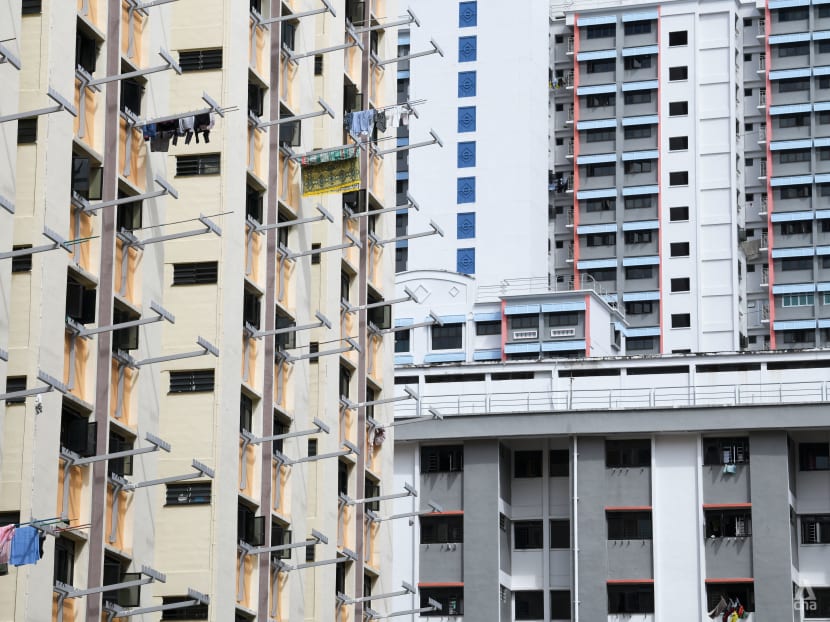Singles unable to buy prime area flats for now, authorities will improve model along the way: Desmond Lee

HDB flats in Singapore. (Photo: CNA/Calvin Oh)
SINGAPORE: Though singles are currently unable to buy flats under the latest Prime Location Public Housing (PLH) model, authorities are “not taking a step backward” in their housing policy for this group, said National Development Minister Desmond Lee on Friday (Oct 29).
Instead, given that the model is brand new, authorities want to first assess its impact and gain experience with it, while making adjustments along the way, said Mr Lee.
Speaking at the Singapore Economic Policy Forum, Mr Lee was addressing concerns that have been raised since the new model was unveiled on Wednesday, including the exclusion of singles from the eligible pool of buyers.
Under the model, singles are not allowed to buy such PLH flats even if they are 35 and above. This is in contrast to current rules, which do not place any restrictions on singles buying resale flats once they turn 35.
“The (restrictions) flow from our BTO criteria, which currently allows singles to buy new two-room flats in the non-mature estates,” said Mr Lee.
He added that authorities understand the concerns of this group.
“Some Singaporeans remain single for a variety of reasons, including obligations to family and parents, or a matter of choice, or a matter of life course – but many still want or need their own living space”.
“They may wonder if we care about their housing needs. To these Singaporeans, let me assure you: We do. We recognise your needs, your aspirations and your sacrifices,” he said.
He added that it is why authorities have been expanding housing options and grants for singles over the years.
“And we’re not taking a step backward in this regard. The new prime location public housing model is brand new, untested in the market … and we won’t be launching that many PLH flats initially.
“So we’re prioritising them, for now, for larger households who may need more space for more people in their families.”
And in the meantime, singles can continue to buy existing resale flats, including many in prime central areas, he said.
“Let us launch this program and policy, assess the impact of the current suite of measures in achieving our objectives, gain experience operating the model – as we make adjustments and improvements along the way, bearing in mind the evolving demographic of Singapore and the changing aspirations of Singaporeans,” he said.
WHY THE RESALE RESTRICTIONS?
Mr Lee also noted that additional eligibility restrictions for the resale of the flats were “one of the deepest points of contention”, which authorities also faced during previous public engagements.
“(People) questioned: Why are we excluding some groups of people from these prime location flats, even upon resale, if our aim is to keep these prime locations inclusive?
“Let me put it this way: It is not our intention to exclude anyone from these prime locations,” he said.
But without some intervention, resale prices would also likely rise out of reach for many Singaporeans, thus excluding them, said Mr Lee.
Authorities settled on reusing the Build-to-Order eligibility criteria, as “an objective set of means-tested conditions that Singaporeans are already familiar with”.
They also cover a broad range of households – for instance, the S$14,000 income ceiling covers more than eight in 10 resident households.
“There will still be many better-off households who don’t qualify. But they should be better able to afford other housing options in these prime central areas, like existing resale HDB flats, or private housing.”
Others also pointed out that an income ceiling would not keep out groups who have low income but high wealth, such as children of well-to-do parents, or wealthy retirees.
To that, Mr Lee said “it is not straightforward to comprehensively means-test one’s wealth”, but rules such as disallowing people from buying a PLH flat until 30 months after they dispose of their private property will go some way to do that.
RENTING OUT THE FLAT
Under the model, owners will not be able to rent out their whole flats, even after the minimum occupation period is over.
Renting out spare rooms is allowed – but some suggested disallowing this too, said Mr Lee.
This is because some flat owners abuse the rule, by locking up one room they claim to be theirs and renting out the rest, though they do not stay in the flat at all.
“We are aware of such cases of abuse ... and we don’t hesitate to take firm action against them when we find out. In some egregious cases, we have even taken back the flat from the owners.”
“So we’ll continue to see how best we can enforce these regulations, especially for prime location flats where the temptation to game the system may be higher,” he said.
INCLUSION OF RENTAL FLATS
On why public rental flats are being included, Mr Lee said it boils down to the commitment to ensuring housing estates are inclusive.
“And let’s not forget that many lower-income Singaporeans work in prime central areas, like in F&B, cleaning, security and so on. They would benefit from living closer to their workplace.”
He added that besides subsidised rent, authorities must also ensure there are affordable food options and amenities for them in the vicinity.
“We have to take a holistic planning approach to uplift the more vulnerable groups in our society.”
He added that overall, no one policy can address every concern, but authorities have tried to strike a balance while also focusing on social objectives.
“And we will continue to review the model over time – like all our housing policies, the PLH model is not cast in stone.”







